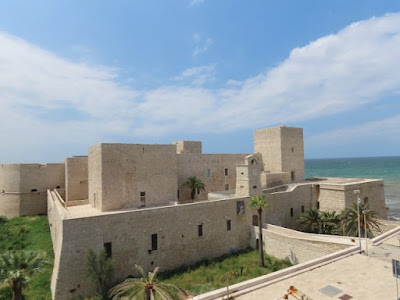Trani
The giant Romanesque cathedral located next to the sea, in Trani, is the key magnet drawing visitors to this Adriatic coastal town. But its list of attractions in Trani is far much bigger.
The harbour brought flourishing city development since the Middle Ages. The town is dotted with nice houses, beautiful churches and palaces. Apart from trade, the seafront is like a paradise for holiday-makers, swimmers and dinners.
Trani prospered during the Norman and Swabian rule around the 12th century. On top of goods trading, it was also a transit point for pilgrims going to Jerusalem. A group of Jews resided in the city and subsequently a Jewish quarter formed. Impressive synagogues remain till today.
The glory of Trani dramatically ended in the 1500s
when the Ottoman Empire dominated. It then became a small fishing city.
 |
| Chiesa Sant'Andrea |
Our coach stopped far outside the city, perhaps one kilometer away from the back of the railway station. Standing in the front of the station is a statue of Saint Francesco and a fountain. The blue pool and bronze statue with the beige walls add lively and cooling elements to the surroundings.
We passed through a delightful maze of medieval streets with well-preserved buildings, cafes and restaurants before we reached our apartment. Oh yes, it's a bit distant between the railway station and the sea.
Our apartment is located at the seafront, next to the Swabian Castle. We enjoyed fabulous views of the castle, architecture near the cathedral and the sea. A lovely place!
Our visit started from a visit to the Cathedral. The imposing white cathedral with yet simple exterior with the background of blue sky and deep blue of the Adriatic Sea composed a stunning scene to wow visitors. The Cathedral was built with local quarries: a calcareous tuff, a rose- white stone. The colour of the facade changes at different times of the day.
Trani Cathedral was constructed on two churches. The lower church is an expansion of the Byzantine S. Maria della Scala built on foundations from the 5th–7th century. The upper basilica was begun in 1099. The high structure imposes a solemn feeling. The simple interior is dotted with intricate art and carvings.
Reserve some time to admire the beauty of the bronze
relief door panels made by Barisano da Trani, an Italian sculptor of the 12th
century.
A small fee is charged for going up to the top of the tower. At our time, the top floor was surrounded with net. A big pity that the splendid 360° views were totally blocked.
Standing at a quiet corner is the historic castle (Castello Seveo di Trani) built by Emperor Frederick II in 1233. This striking fortress has a classic quadrangular form, with robust square towers at each corner. It has recently been restored and is now open to the public and hosts frequent concerts, art exhibitions and other cultural events.
The old town centre, a charming medieval network of
streets with plenty of fine architecture, is arranged around the picturesque
fishing port. The harbour-front features numerous bars, cafés and fish
restaurants.
Close to the historical center is a villa at a stunning location with a balcony overlooking the sea. A part of the Commune Park (Villa Comunale) connects to a pathway along the sea. Beaches, cafes, bars provide many resting places. The Park was quite filled up with families and chatting friends. Still, we felt very relaxed given the space and minimal noise. A beautiful marble statue of war memorial stands proudly to grab your attention.





































Comments